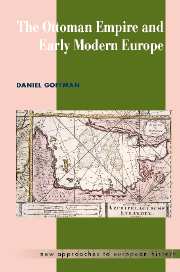Book contents
- Frontmatter
- Contents
- List of illustrations
- List of maps
- Preface
- Acknowledgements
- Note on usage
- Chronological table of events
- The Ottoman House through 1687
- 1 Introduction: Ottomancentrism and the West
- Part 1 State and society in the Ottoman world
- Part 2 The Ottoman Empire in the Mediterranean and European worlds
- Kubad in Venice
- 5 The Ottoman–Venetian association
- Kubad between worlds
- 6 Commerce and diasporas
- Kubad ransomed
- 7 A changing station in Europe
- 8 Conclusion: The Greater Western World
- Glossary
- Suggestions for further reading
- Index
- NEW APPROACHES TO EUROPEAN HISTORY
5 - The Ottoman–Venetian association
from Part 2 - The Ottoman Empire in the Mediterranean and European worlds
Published online by Cambridge University Press: 05 June 2012
- Frontmatter
- Contents
- List of illustrations
- List of maps
- Preface
- Acknowledgements
- Note on usage
- Chronological table of events
- The Ottoman House through 1687
- 1 Introduction: Ottomancentrism and the West
- Part 1 State and society in the Ottoman world
- Part 2 The Ottoman Empire in the Mediterranean and European worlds
- Kubad in Venice
- 5 The Ottoman–Venetian association
- Kubad between worlds
- 6 Commerce and diasporas
- Kubad ransomed
- 7 A changing station in Europe
- 8 Conclusion: The Greater Western World
- Glossary
- Suggestions for further reading
- Index
- NEW APPROACHES TO EUROPEAN HISTORY
Summary
In an aesthetic sense at least, [Venice] still holds the east in fee, as the place where orient and occident seem most naturally to meet: where the tower of Gothic meets the dome of Byzantine, the pointed arch confronts the rounded, where hints and traces of Islam ornament Christian structures, where basilisks and camels stalk the statuary, and all the scented suggestion of the east is mated with the colder diligence of the north. Augsburg met Alexandria in these streets long ago, and nobody fits the Venetian mis-en-scène better than the burnoused sheikhs so often to be seen these days feeding the pigeons in the Piazza, leading their veiled wives stately through the Merceria, or training their Japanese cameras upon St Theodore like that contorted sightseer in the old picture.
After the Ottomans conquered Constantinople in 1453 a few key cities more and more constituted that empire's nexus with the rest of Europe. Some, such as Venice or Vienna, existed outside of the empire; most, such as Istanbul, Izmir, and Aleppo, were Ottoman. The principal cause for this skewed situation can be found in the tenets of Christianity and Islam as displayed in the two halves of the early modern Mediterranean world. Whereas, in the Catholic northwest, Iberian and Italian states strictly restricted access to their cities, in the Muslim southeast the Ottoman state allowed diverse settlement.
- Type
- Chapter
- Information
- The Ottoman Empire and Early Modern Europe , pp. 137 - 164Publisher: Cambridge University PressPrint publication year: 2002



